Reader Survey: Talking pallets with Modern’s readers
From wood to plastic to pallet pools, our readers tell us what’s important in pallets.
Latest Material Handling News
NetLogistik partners with Vuzix subsidiary Moviynt to offer mobility solutions for warehouses Lucas Watson appointed CSO for Körber’s Parcel Logistics business in North America Hyster recognizes Dealers of Distinction for 2023 Carolina Handling names Joe Perkins as COO Walmart deploying autonomous lift trucks at four of its high-tech DCs More NewsRecently, we read a case study about how CHEP and IFCO worked with a food distributor to develop a new pallet management program. The project involved the implementation of a dock sweep program to pick up CHEP pallets shipped to the distributor and a new design for better performance of the used wooden pallet shipped to the distributor’s customers. “The industry is really becoming more consultative and service based rather than product based,” a spokesperson from CHEP told Modern.
That change may not yet be fully reflected in the broad market. In fact, 56% of respondents in Modern’s annual survey of pallet users said purchase price was the most important factor in their decision to use a certain type of pallet. That was more than any other factor. But, it is reflective of feedback we hear from system integrators, who are beginning to understand that a poorly built pallet can wreak havoc on their automated systems, and consultants who are now paying attention to how their clients’ loads perform after they come off the end of the packaging line. In other words, pallets and the associated transport packaging are more of a priority than ever.
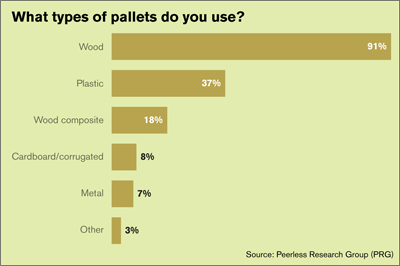
That may explain why the pallet market continues to grow, even as shippers look for alternatives to the every day wooden pallet. Research firm Freedonia Group expects the pallet market to grow by 3.5% a year through 2017. While modest, that’s a growth rate that is faster than the overall economy.
How then does the user community view pallets? To answer that question and others, we surveyed subscribers of Modern as well as a sample of recipients of our e-newsletters. We received 353 qualified responses, defined as a reader who is employed at a location that uses pallets. Here’s what we learned. Read last year’s survey.
Purchasing decisions
A number of factors go into the decision to buy a certain type of pallet. And, while purchase price remains the most important factor, cited by 56%, it was down from 63% of readers the prior year. Cost per use was cited by nearly 40% of respondents, suggesting not only that cost is important, but that readers are getting more than one trip out of their pallets.
Other leading factors include:
- 53% strength,
- 50% durability,
- 43% customer requirements,
- 40% reusability, and
- 32% availability.
Wood pallets still predominate. They are used by 91% of readers. However, pallets manufactured from alternative materials are in the mix, with some readers also using:
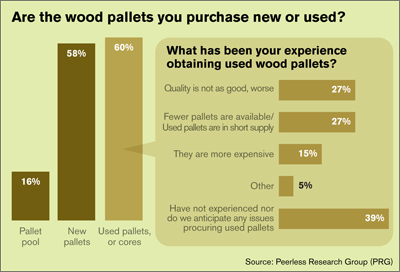
More importantly, there appears to be a growing interest in alternative pallets. In its most recent report, Freedonia noted that plastic pallets are expected to record above average growth. The research group also predicted that metal pallets will notch the biggest percentage gains of any of the three most common pallet types (wood, plastic, metal).
Those projections are supported by Modern readers: 34% indicate they used more plastic pallets during the last 12 months, compared to 27% who reported they were using more plastic pallets in last year’s survey; 33% expect to increase their usage of plastic pallets in the next 12 months. Most respondents said they are attracted to the cleanliness and longer life span of plastic pallets:
Although Freedonia Group predicts increasing demand for metal pallets, only 4% of respondents expect to start using metal pallets in the next 12 months, and only 8% expect their usage to increase in the next 12 months.
Readers indicate they are exploring metal pallets because they are durable, cleanable and conductive; because their customers want options besides wood and plastic; and because they are exploring options for reusable pallets.
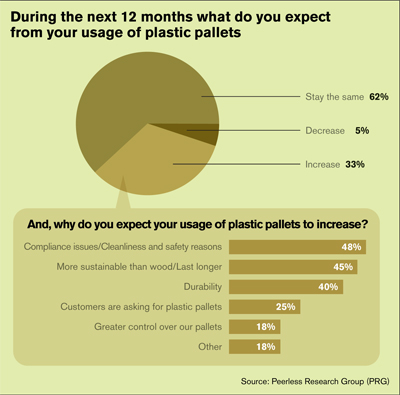
The 48 x 40-inch is still the most commonly used size of pallet, according to 58% of readers. That was a significant change from the 81% that reported using 48 x 40-inch pallets last year. Still, no other size was being used by more than 17% of respondents. Only 8.3% reported that they are shipping on a 24 x 20-inch half pallet, down from 10% in last year’s survey.
The number of respondents who are using pallets to ship globally dipped from 57% to 55% this year, while the number that report they only ship domestically rose from 39% to 42%. Only 3% ship on pallets solely to international customers. If pallets are a leading indicator of economic activity, this slight dip coincides with the drop in exports from U.S. manufacturers.
Like last year, the leading recipients are our closest neighbors, including Canada (80%), Mexico/South America/Carribean (67%), China/Asia (63%), Western Europe (50%) and Eastern Europe (39%). Keep an eye, however, on the Middle East and North Africa (33%).
International business does require a different pallet strategy for most shippers, with only 22% reporting that they don’t do anything differently for international and domestic deliveries. Some of the strategies include:
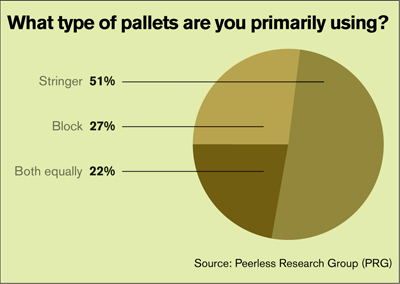
It’s still a wooden pallet market
While plastic, presswood and metal pallets are taking some market share, no alternative is as versatile and cost-effective as new, used or pooled wooden pallets.
Modern’s readers appear to take a strategic approach to pallet usage—given the percentages, a typical respondent is probably purchasing both new and used pallets, and some are also participating in a pallet pool. In all likelihood, these decisions are driven by the requirements of their customers. However, there were some slight changes in the dynamics.
The number of respondents using a pallet pool remained constant at 17%. However, the gap between the purchase of used and new pallets narrowed. In 2012, nearly 63% reported that they rely on used pallets, also known as cores, while 59% said they purchased new pallets. In 2013, 60% say they purchase used pallets, while 58% say they purchase new pallets.
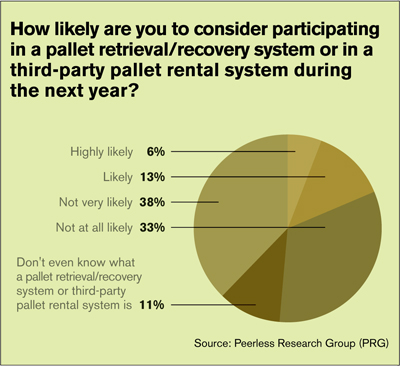
Similarly, the number of readers who report they are using more used pallets this year dropped to 42% from 46% in 2012.
The change can be explained, at least in part, to the shortage of cores that has plagued the market for several years and showed up in Freedonia’s research.
For instance, although 39% of readers say they have not experienced any issues in procuring used pallets, 27% report that the quality of used pallets has deteriorated; 27% say that fewer used pallets are available; and 15% say they have become more expensive. Of those readers who have experienced price increases, 48% have seen a spike of 5% to 9%, and 24% have seen a spike of from 10% to 14%.
In response to these issues, 64% of readers say they will buy more new pallets, and 13% say they plan to create and manage their own pools. Just 4% say they plan to rent from a pallet pool such as those from CHEP, PECO and iGPS.
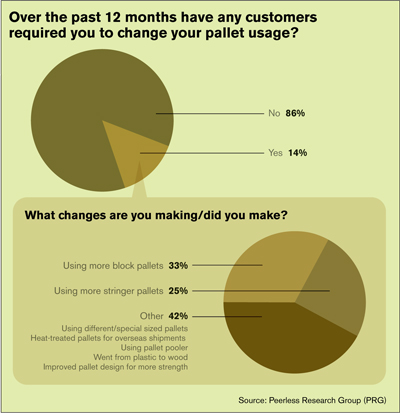
Block or stringer
At the grocery store, the question is paper or plastic? When it comes to wooden pallets, the question isn’t just used or new, it’s also stringer versus block? The stringer pallet design is favored by standard pallets such as the 48 x 40-inch GMA, the most commonly used pallet on the market. The block pallet design, favored by plastic pallet makers as well as wooden pallet pooling organizations like CHEP and PECO, got a boost two years ago when Costco became the first retailer to require its suppliers to ship product on block pallets.
Beginning with last year’s survey, we began to look to see if the Costco requirement is having an impact on the pallet market. A few trends are beginning to appear.
First, as with the new versus used question, block or stringer isn’t an either/or question. More than half (51%) of readers are shipping solely on stringer pallets and 27% are shipping solely on block pallets. Another 23% are shipping on block and stringer pallets in equal measure. In other words, a significant percentage (50%) is shipping some loads on block pallets. That is up from 47% in 2012.
Second, a relatively small percentage of readers (14%) have been asked by customers to change their pallet usage. Of those, 33% are using more block pallets compared to 25% that are using more stringer pallets.
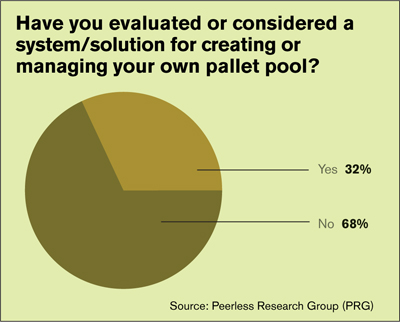
Changes are being requested from a variety of points in the supply chain. According to respondents, 46% are from the manufacturers; 36% are from the retailer; and 26% are from the wholesalers.
As with last year, Costco appears to be one of the few companies planning to require its suppliers to ship solely on block pallets.
Get into the pool
Nearly 50% of food, beverage and consumer packaged goods currently ship on a pooled 48 x 40-inch pallet, according to some sources. Pooled pallets, especially plastic pallets, are also used by auto suppliers, pharmaceutical makers and food and beverage manufacturers with tight control over their manufacturing and distribution operations. In fact, nearly 44% of respondents said they either use a pallet rental company, such as CHEP, PECO or iGPS, or they have a pallet retrieval or recovery system in place.
Still, it means that 56% of respondents are purchasing their pallets or reshipping on pallets delivered to them by suppliers. Looking forward, most companies plan to continue with their current strategies. A majority of readers say they are not very likely (38%) or not at all likely (33%) to participate in a pallet or pallet management program, while 19% say they are likely (13%) or very likely (6%).
Of readers who would consider participating in a pallet pool, 55% report that they would explore creating or managing their own pool; 32% say they have already evaluated or considered creating or managing their own pool.
Finally, we asked how interested are readers in using a pallet pooling service managed by the pallet industry as an alternative to established pools managed by CHEP, PECO and iGPS.
The responses were almost identical to last year’s survey: roughly 14% indicate they are interested or highly interested. And, 69% indicate they are not very or not at all interested.
As the building block of unit loads and the most fundamental transport packaging, we’ll continue to watch the pallet market over the next year.
Companies mentioned in this article
CHEP: chep.com
IFCO Systems: ifco.com
Fredonia Group: fredoniagroup.com
PECO: pecopallet.com
iGPS: igps.net
- 37% plastic pallets,
- 18% wood composite,
- 8% cardboard/corrugated, and
- 7% metal.
- 48% said compliance issues/cleanliness and safety reasons;
- 45% said plastic pallets are more sustainable than wood and last longer;
- 40% said plastic pallets are more durable than wood;
- 25% said customers ask for plastic pallets; and
- 18% said customers have greater control over their pallets.
- 45% treat their pallets;
- 18% use alternative materials other than wood that don’t require treatment;
- 12% use wood pallets from their own pool; and
- 6% use a pallet pool for international shipments. This is double the 3% who reported using a pallet pool for international shipments in 2012.

Article Topics
Latest in Materials Handling
NetLogistik partners with Vuzix subsidiary Moviynt to offer mobility solutions for warehouses Materials Handling Robotics: The new world of heterogeneous robotic integration Lucas Watson appointed CSO for Körber’s Parcel Logistics business in North America Hyster recognizes Dealers of Distinction for 2023 Carolina Handling names Joe Perkins as COO C-suite Interview with Keith Moore, CEO, AutoScheduler.AI: MODEX was a meeting place for innovation Walmart deploying autonomous lift trucks at four of its high-tech DCs More Materials HandlingAbout the Author
Subscribe to Materials Handling Magazine

Find out what the world's most innovative companies are doing to improve productivity in their plants and distribution centers.
Start your FREE subscription today.
April 2024 Modern Materials Handling

Latest Resources










